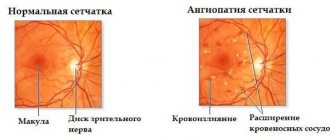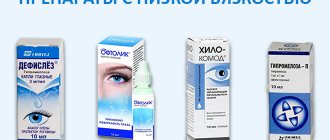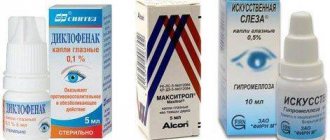There are a number of rules on what and how to wash your eyes with conjunctivitis. Washing the eyes relieves inflammation of the mucous membrane, soothes the irritated conjunctiva, and cleanses of small dust particles, pus and other secretions. When combined with medications, it accelerates the recovery of the affected organ.
- 3.1 Video: How to wash your eyes with tea leaves for conjunctivitis?
- 4.1 Video: How to properly treat a child’s eyes
Adaptations
There are several methods for washing your eyes. They differ in the use of different devices. For example:
- using a pipette;
- using eye baths;
- use of cotton pads.
Rinsing with a pipette
How to use:
- Dip the sterilized pipette into the prepared medicinal liquid, squeeze and release the rubber part of the pipette, so the liquid will fall into it.
- Then the patient needs to tilt his head back a little, pull back the lower eyelid, place the pipette directly above the open eye and, without touching it, squeeze out a little liquid.
- When liquid gets into the eye, you need to blink several times before it flows out, so if you do this procedure, the child needs to hold his head for a while.
- For maximum effect, repeat again.
- Then gently dry your face with a soft, clean, dry cloth or towel.
This method is most often used to wash the eyes of children.
Also, with this method, you can use a syringe without a sharp needle or a bulb.
Rinsing with eye baths or containers
Instructions for use:
- The bath or glass is sterilized, medicinal liquid is poured into it, the head is tilted forward and the face is pressed tightly against the bath, so that the eye is inside it.
- You can simply blink several times in this position, but for greater efficiency, if you are using a small eye-sized container, you need to tilt your head back without letting go, open your eyes as wide as possible and blink several times.
- Then return to the starting position and, removing the eye from the water, blot it with a clean napkin.
- If you want to repeat the procedure and when rinsing the other eye, you must either use another clean container, or sterilize this one again by pouring fresh solution into it.
There are special glasses and baths that are made exactly according to the oval of the eye. This method is only suitable for adults or older children.
Rinsing with cotton pads
This type of washing is very popular and is even used for infants. A cotton pad should be soaked in the medicinal liquid, then tilt your head to the side, placing a container in front of you where the used water will drain, or stand next to the sink. You need to direct the moistened cotton wool in the direction from the outer corner of the eye to the inner one. Sometimes, with dried discharge, you should leave a moistened disc on the eye for some time. To perform this operation with the other eye, you need to take another cotton wool.
How to wipe properly?
It's not difficult to do this. You can use one of two acceptable methods.
The first method is rinsing using cotton pads. The disc is dipped into the solution and slightly wrung out. Use your finger to move the lower eyelid back and lightly rub it there. In this case, you need to start from the inner corner of the eye and move towards the outer corner.
Application sequence:
- Wash your hands thoroughly.
- Moisten two cotton or gauze swabs and squeeze them lightly.
- Gently push back the lower eyelid.
- Use the disc to move from the inner corner of the eye to the outer corner.
Expert opinion
Ermolaeva Tatyana Borisovna
Ophthalmologist of the highest category, Candidate of Medical Sciences
Both eyes are washed with different disks, even if one of them is healthy.
When treating conjunctivitis, did you wash your eyes with solutions?
YesNo
With the second method, you should purchase special eye cups in advance that look like a funnel. They are available at any pharmacy.
The peculiarity of this method is that the person should not close his eyes during the procedure. This way the therapeutic effect is better achieved. This method is also good for removing a foreign body in the eye. You need to pour liquid into the visual organ without much pressure. These are the most common ways to wash your eyes. There are other methods using improvised objects, for example, a rubber bulb. The pear is first boiled in water, after which the solution is taken into it and poured into each conjunctival sac. A similar action can be performed using a sterile pipette.
Another way is to purchase a special bath at the pharmacy. A rinsing solution is poured there, and then one eye and then the other eye are lowered in turn.
It is worth remembering that each wash requires the preparation of a new solution. The number of rinses and duration are determined by the ophthalmologist. Typically, for children under 3 years of age, this procedure is performed every 2 hours for 1-2 days. After which it is carried out 3 times a day.
How to wash eyes for conjunctivitis in children?
Great care must be taken when washing the sore eyes of a child, especially a small one, try not to harm him. Show your child to a specialist so that he can tell you what to wash your baby’s eyes with, since there may be an intolerance or allergy to some medicinal ingredients, and the mixture used may not be suitable for age.
The following liquids are most often used to wash the eyes of children with allergic conjunctivitis:
- warm boiled water;
- saline;
- tea decoction
For bacterial and viral conjunctivitis, it is more effective to use agents with an antiseptic effect, for example:
- Furacilin;
- camomile tea;
- potassium permanganate;
- boric acid;
- Albucid;
- Miramistin and other medicinal solutions.
But do not forget that the use of any medications is prohibited without consulting a specialist.
Features in children
These rules are especially important for babies who may resist rinsing. First, you need to wash your hands well. After which it is advisable to swaddle the child so that he does not interfere with the procedure itself.
A pipette is used for washing. To do this, you need to move the lower eyelid and drop a couple of drops closer to the inner edge of the eye. After this, run your finger over the closed eye towards the outer edge.
Expert opinion
Ermolaeva Tatyana Borisovna
Ophthalmologist of the highest category, Candidate of Medical Sciences
The child can also be washed using a sterile napkin.
Eye washes
You can simply wash your eyes from purulent discharge and inflammation with warm boiled water. Don't forget that each eye needs to be processed separately.
Saline solution
An effective eye wash for conjunctivitis is saline solution. Ready-made saline solution is sold in pharmacies and is convenient to use. But you can cook it yourself. You need to take one tablespoon of salt and dissolve it in a glass of warm boiled water. For children, the concentration should be reduced - one teaspoon per liter of warm water.
Strong tea
Tea infusion is also used to wash the eyes, but does not have the same effect as other remedies. It is used only if it is impossible to get to the pharmacy and if there are no other means at hand. You should take yesterday's tea, strong enough and without various aromatic additives. But you should not use tea that has been standing for more than two days, as bacteria are activated in it. It is not recommended to wash the eyes of a small child with tea.
Furacilin
A solution of this product is very popular for washing the eyes of both children and adults. You can purchase a ready-made sterile solution at pharmacies, or you can prepare it at home.
Instructions:
- To prepare the solution, take one tablet, grind it to powder, and dissolve it in one hundred milliliters of warm water, stirring vigorously, then leave it for some time.
- Before use, the solution must be passed through a thick layer of gauze to avoid getting small residues that have not dissolved into the eye.
- It must be stored in the refrigerator in a dark container, since the medicine loses its properties in the light.
- Bring it to room temperature before use.
- After three days, make a new solution.
Potassium permangantsovka
Another remedy often used for washing eyes for all ages is a solution of potassium permanganate or potassium permanganate.
Important! The solution should be only slightly pinkish. Don't forget to mix it thoroughly so that there are no undissolved crystals.
Despite the fact that potassium permanganate is indeed often recommended for washing the eyes, we do not recommend using it.
Herbal infusions
Chamomile infusion is used especially successfully in children and adults. To obtain it, take two teaspoons of dry chamomile and brew it in sixty milliliters of boiling water, be sure to cover the infusion and let it stand for five to ten minutes, pass through a thick layer of gauze before use. Although this remedy is used quite often, its effect is very weak.
Boric acid
A solution of boric acid was often used to wash eyes by our grandmothers. To make the correct two percent solution, which is considered not dangerous to the eyes, you need to take five grams of powder and dissolve it in warm boiled water. Apply the cotton pad soaked in the solution only to your closed eye.
Be extremely careful if you decide to use this product!
Albucid
When using such a widely used product as Albucid, you should definitely consult a doctor. Albucid is used for adults and children, only in different concentrations. For adults - thirty percent, and for children - twenty percent.
Before using the product, you need to cleanse the eye of purulent formations.
Miramistin
It comes in different forms; a 0.01% solution of this product is used to wash the eyes for conjunctivitis in children and adults. With a medicine of exactly this concentration, you can moisten a cotton swab without diluting it and wipe your eyes, removing purulent accumulations.
Chlorogexidine
This is a drug that is also effectively used to wash the eyes for conjunctivitis. For adults you can use a 0.05% solution, and for children a 0.02% solution. In pharmacies you can find either a concentrate or a 0.05% solution, so it should be diluted with warm boiled water. You need to close your eyes and carefully remove the pus with a cotton swab, trying not to get the medicine on the eyeball. If the solution gets into your eyes, rinse them with warm water.
This medicine should be used with caution, only after consultation with a specialist.
Penicillin
To get an effective medicine for washing the eyes for conjunctivitis, take one bottle of powdered penicillin, fill the bottle to the brim with boiled or distilled water, after dissolving the powder, you can wash the eyes with the mixture. Store the mixture for no more than two days in the refrigerator.
Be sure to consult your doctor before using this product.
Hydrogen peroxide
Under no circumstances should you wash your eyes with hydrogen peroxide. Since there is a very high risk of getting burned. When choosing any remedy, always consult your doctor, he will be able to prescribe exactly the treatment that suits you.
When washing your eyes with conjunctivitis with any means, you need to be extremely careful, especially for infants. Use all medications only after consulting your doctor; before the visit, simply wipe your child’s eyes with warm water. Further, during treatment, monitor the effect of the medicine, even if your doctor prescribed it to you. Allergic reactions and unpredictable consequences are possible if you are intolerant to any substances; in such cases, see a doctor immediately.
Traditional medicine
To wash your eyes, you can use not only pharmaceutical products, but also traditional medicine methods, which also have a good therapeutic effect:
Do you use traditional medicine?
Not really
- Chamomile solution. To do this, take a teaspoon of dry raw material per glass of boiling water. After infusion and filtering, the solution can be used for its intended purpose.
- Yarrow decoction. It has bactericidal properties. The brewing sequence is the same: take a glass of boiling water for a dessert spoon of herb. Only after this the infusion is placed in a thermos and left for a couple of hours. If the product turns out to be concentrated, then it is mixed with a small amount of water, after which the eyes are wiped.
- Strong tea. You can use both black and green tea leaves without various flavors.
Preparing to wipe and wash your baby's eyes
Preparation involves washing your hands with antibacterial soap or using antiseptics. You should not touch a child’s eyes with dirty hands, much less wash and wipe them. There is a risk of introducing more pathogenic microorganisms and worsening the baby’s condition.
Prepare clean cotton pads and medicine. Swaddle the baby, if he squirms a lot, place him with his back on the changing table.
It is recommended to rinse the eyes from the outer corner to the bridge of the nose. Thus, all the pus comes out. If necessary, change the cotton swab. If the procedure is carried out in the opposite direction, the pus will not come out completely; part of it will remain in the eye and penetrate into the deeper structures of the visual organ.
Do not leave excess medication in the eye. Remove with a dry cotton swab.
Compresses for eyes
Source: infectus.ru
Using a compress can reduce eye irritation. To make a compress, use a cotton swab or a very clean cloth. Choose one of the products suggested below, soak a swab in it and apply it to the eye for 10 minutes or more. Apply the compress to the eye as many times as necessary for healing.
Compress with water
One of the simplest remedies is a compress with warm or cold water. Apply a warm compress to your eyes to soothe irritation and prevent sticky discharge from drying eyelashes, or a cold compress to reduce swelling and itching. Do this for 5 minutes 3-4 times a day.
Many bacteria that cause conjunctivitis do not like heat, so a hot compress will be helpful. Use a hot compress 3-4 times a day, but be sure to check the temperature before applying it to your eyes to make sure it is not too hot.
Folk remedies are effective at the early stage of the disease. It is strictly not recommended to self-medicate for childhood conjunctivitis, but options for using traditional medicine in adults are successfully practiced.
A sterile gauze swab is soaked in the broth and placed on the eyes. This procedure is carried out 2 times a day - morning and evening. The product is suitable for both eye rinsing and lotion. Solutions for lotions are varied, they are mainly made from:
- dried chamomile flowers;
- black tea;
- bay leaf;
- castor oil;
- boric acid.
Conjunctivitis: types and symptoms
Depending on what caused the disease, conjunctivitis is classified as viral, bacterial or allergic. If the disease began acutely and spontaneously, we are talking about an acute form; if the symptoms last for several weeks, then the conjunctivitis is chronic.
The patient exhibits the following symptoms:
- the whites of the eyes turn red;
- the eyelids also become red and swollen, becoming painful;
- increased tearfulness begins;
- During the day, especially in the morning, there is purulent discharge from the eyes;
- in severe cases of the disease, an increase in body temperature is possible.
The presence of purulent discharge is characteristic of the viral form of conjunctivitis. In this case, rinsing becomes especially important. The best way to wash your eyes depends on how severe your symptoms are.
Children become infected with conjunctivitis somewhat more often than adults. The statistics are explained by the fact that it is not always possible to ensure that a child does not touch his eyes with dirty hands - this is very easy to spread an infection.










